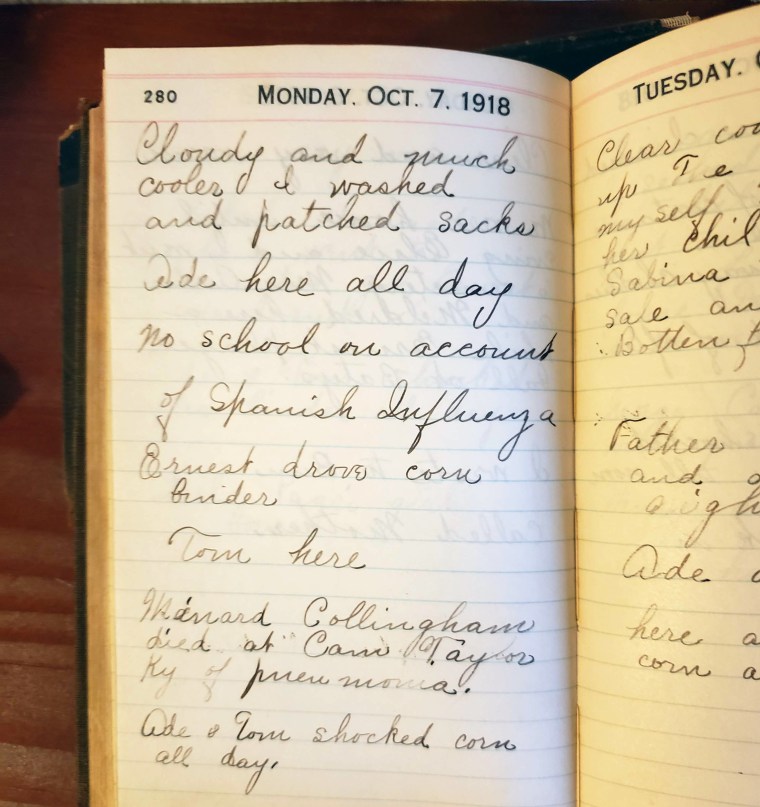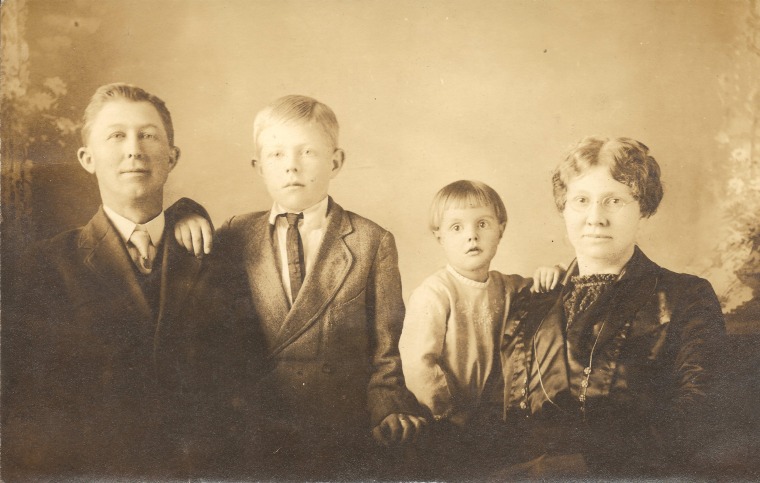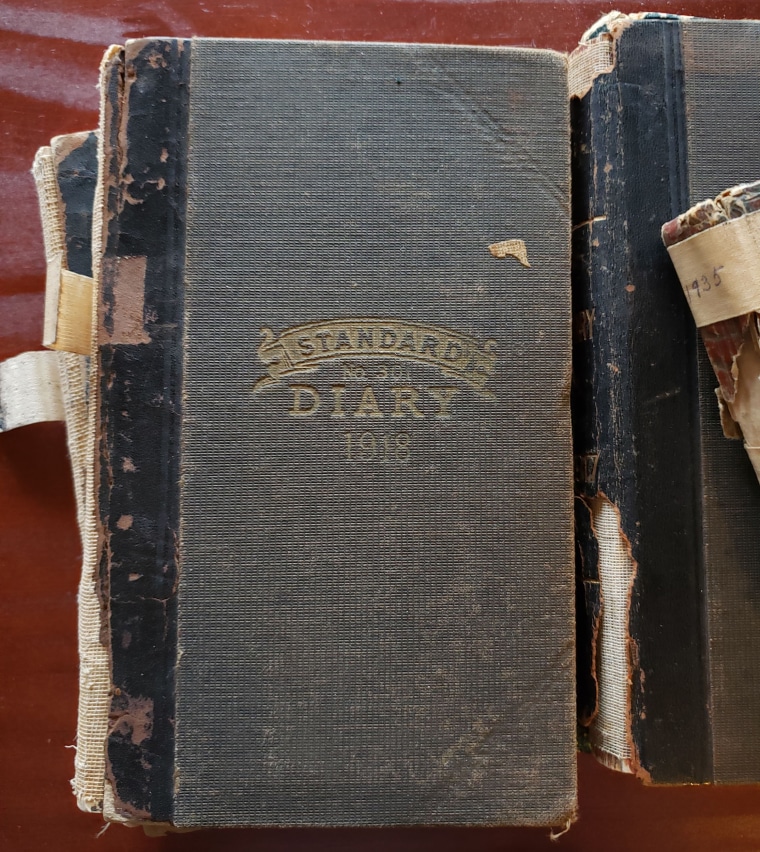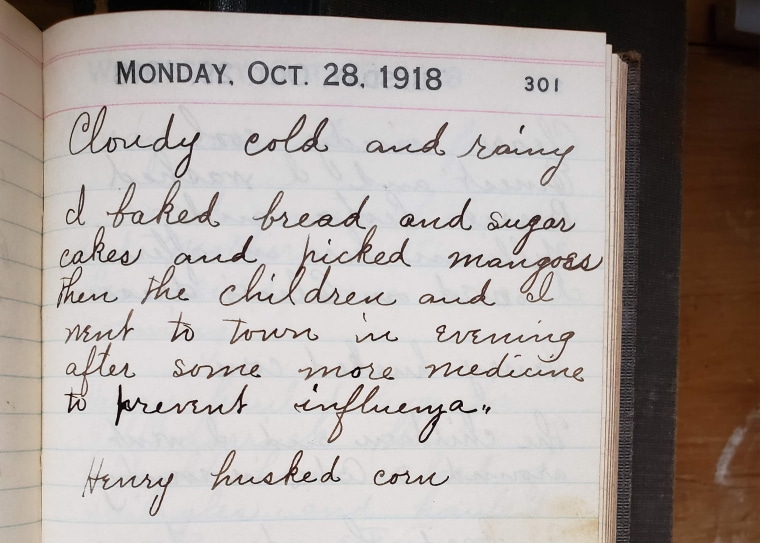The diary entries from a woman in southwestern Ohio about farm work and life during the 1918 flu pandemic and World War I have brought her future generations comfort and hope as the nation grapples with the coronavirus pandemic.
“No school on account of ‘Spanish Influenza’,” Lucy Vandervort Cox, who died in 1964 at age 84, wrote in her diary entry on Monday, Oct. 7, 1918, on a “cloudy and much cooler” day in Wilmington.
Jennifer Weinbrecht, 63, preserved her great-grandmother's diaries which were written from 1899 to 1964 and later passed down to her from her deceased mother, JoAnne Womacks.

The diaries, which Weinbrecht also refers to as ledgers, show a snapshot of the hard work of farm life and raising a family. Kept mostly in the form of a log of daily activities, they offer some additional snippets of what life was like during the 1918 influenza pandemic.
“I look up names or words in my great-grandmother’s rather sparsely worded diaries and learn a wealth of information,” Weinbrecht told NBC News from Novelty, Ohio. “Sometimes, it’s fun stuff – like when she said she finished her Mother Hubbard, and I Googled that and found it was a dress that could be worn without a tight corset for working on the farm,” she said.

‘Grandma Cox’, as she's affectionately referred to, worked on a vegetable farm in Wilmington with her husband, Henry, and raised two children, Ernest and Elsie. Elsie, Weinbrecht’s grandmother, was the daughter of Cox’s brother but was adopted into the family when the child’s mother died.
Weinbrecht began years ago to transcribe the diaries in hopes of further preserving her family’s history. The family revisited them recently when her daughter Amy Patterson, 38, wanted to see what advice they could glean as they stayed indoors to stay safe from the pandemic.

Patterson, who works as a part-time reporter for the Geauga County Maple Leaf in Chardon, Ohio, wrote a piece for the newspaper about how the lessons learned from the 1918 flu could help readers conquer COVID-19.
“While a global pandemic shuttering schools and businesses feels like new territory, many of our families still bear the scars of the 1918 influenza pandemic,” she wrote.
Roughly 50 million people around the world died from the 1918 H1N1 flu pandemic, also referred to as the Spanish flu, according to the Centers for Disease Control and Prevention. In the United States alone, about 675,000 people were killed at the time.
Ohio has 14,694 confirmed cases of COVID-19 and 656 deaths from the novel coronavirus, according to the Ohio Department of Health. In the United States, as of Friday, there were 828,441 cases and 46,379 deaths overall, including probable cases and losses. Ohio and many other states have issued stay-at-home orders, with a small number of states opting not to issue such restrictions.
As the world grapples with the coronavirus pandemic and quarantines, Patterson felt that looking back into her family’s history might bring some hope, connection and perspective.
Patterson, who has two sons, ages 9 and 11, decided to read through some of the entries to see how they related to her own family’s experiences now.
“It just felt like a really good time to evaluate how bad this is, compared to how bad our ancestors had it,” Patterson said over the phone from Chardon.
In one entry, Cox wrote about cooking and how her husband, Henry, shucked corn.
“I baked bread and sugar cakes and picked mangoes,” she wrote on Monday, Oct. 28, 1918. “Then the children and I went to town in [the] evening after some more medicine to prevent influenza.”

Patterson recalled how her great-great-grandmother’s younger brother was away serving in the war, how school and church had been closed due to flu precautions, yet Cox continued doing farm work and putting her family first.
“My kids are struggling with not being connected to their friends at school,” Patterson said. “It’s that time of life like, they’re learning how to be social and having been forced to do that in person to doing it across the screen is not ideal, but I feel that we’re almost more connected than we were before.”
She credits Grandma Cox’s story for some of that. “We’re sending these family photos back and forth. My kids are asking questions about our family, because of this story,” she said.
In another diary entry, Cox described what seemed to be a normal day, what the family ate -- she baked a cake and some bread, she took a trip into town with the children -- a typical November day that was “clear” but had a “very cold wind.” The entry concludes with one sentence about the passing of 14-year-old Mary who succumbed to the flu. A very stark reminder of the virus that was taking a toll on her community.

Then the following month, she recorded the names of more lives lost to influenza.
“But, between the deaths and funerals adding up on Lucy’s ledger, she also recorded signs of everyday life – visits to town, minor injuries to the children and several weddings – in a sign that life was still moving forward, even in the midst of a world at war,” Patterson wrote.
Weinbrecht, who owns a bookstore called Jane Austen Books with her two daughters, said she has been transcribing and digitizing the decades of diaries. So far, she’s up to 1935.
“They can’t stop. Even when [Grandma Cox] says, 'Oh, I feel really bad,' she just has to keep going,” Weinbrecht said.
